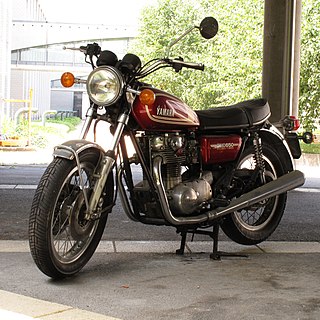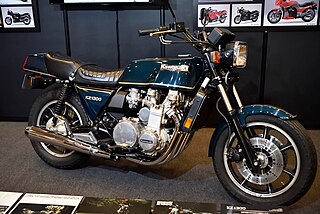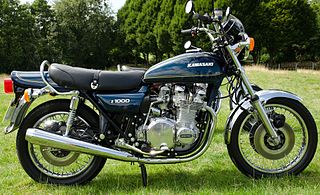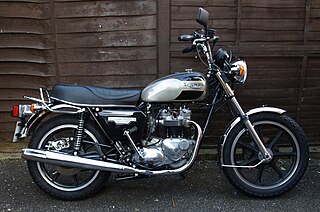
A straight-twin engine, also known as an inline-twin, vertical-twin, or parallel-twin, is a two-cylinder piston engine whose cylinders are arranged in a line along a common crankshaft.
The Honda XR series is a range of four-stroke off-road motorcycles that were designed in Japan but assembled all over the world.

The Honda CX series motorcycles, including the GL500 and GL650 Silver Wing variants, were developed and released by Honda in the late 1970s, with production ending in most markets by the mid 1980s. The design included innovative features and technologies that were uncommon or unused at the time such as liquid cooling, electric-only starting, low-maintenance shaft drive, modular wheels, and dual CV-type carburetors that were tuned for reduced emissions. The electronic ignition system was separate from the rest of the electrical system, but the motorcycle could only be started via the start button.

The Kawasaki Z500/Z550 series began with the 1979 Z500, a scaled-down version of the Kawasaki Z1R. It used a double-cradle steel frame with a transverse-mounted air-cooled 4-cylinder DOHC engine—a classic Universal Japanese Motorcycle.

Universal Japanese Motorcycle (UJM) is a US motorcycling media term for a general-purpose style of Japanese standard motorcycle that revolutionized the industry and made motorcycling in America more accessible during the 1970s and 1980s. By around 1990 its popularity began to wane as the market fragmented into more specialized designs.

The Kawasaki Z650 was produced as a 652 cc (39.8 cu in) standard motorcycle by Kawasaki from 1976 until 1983. It had a four-cylinder four-stroke, DOHC, air-cooled, wet sump engine positioned across the frame with two valves per cylinder and a five-speed gearbox. Designed as a middleweight version of the Kawasaki Z900, the similar-styling had "an attenuated version of the traditional Kawasaki tail fairing". It competed in the market against the smaller SOHC Honda CB650. The Z650 was the epitome of the "Universal Japanese Motorcycle" (UJM).

The Yamaha XS650 is a mid-size motorcycle made by Yamaha Motor Company. The standard model was introduced in October 1969,and produced through 1979. The "Special" cruiser model was introduced in 1978 and produced through 1985. The XS650 began with the 1955 Hosk SOHC 500 twin. After about 10 years of producing 500 twin, Hosk engineers designed a 650 cc twin. Later the Hosk company was acquired by Showa Corporation, and in 1960 Yamaha had bought Showa with Hosk's early design of 650 cc twin.

The Vulcan name has been used by Kawasaki for their custom or cruiser motorcycles since 1984, model designation VN, using mostly V-twin engines ranging from 125 to 2,053 cc.

A motorcycle engine is an engine that powers a motorcycle. Motorcycle engines are typically two-stroke or four-stroke internal combustion engines, but other engine types, such as Wankels and electric motors, have been used.

The Honda CB500 Four is a standard 498 cc (30.4 cu in), air-cooled, 8-valve, SOHC, transverse inline-four motorcycle made by Honda from 1971 to 1978. It was introduced at the London Racing and Sporting Motorcycle Show in February 1972, and sold in the US market until 1973, replaced by the CB550 in the 1974 model year, while continuing in the European market until 1978. The CB500 Four is styled like the CB750, but smaller and lighter, with a claimed of 50 bhp (37 kW) output and a top speed of 115 mph (185 km/h).

The Triumph Trident and BSA Rocket 3 was a technically advanced, high-performance roadster motorcycle made by Triumph Engineering and BSA from 1968 to 1975, and sold under both the Triumph and BSA marques. Alongside the Honda CB750, and later the Kawasaki triples, it brought a new level of sophistication to street motorcycles, marking the beginning of the superbike era. The Honda CB750 overshadowed the Trident to be remembered as the 'first superbike', in spite of the Triumph Trident actually debuting before the Honda by a few weeks.

The Kawasaki triples were a range of 250 to 750 cc motorcycles made by Kawasaki from 1968 to 1980. The engines were air-cooled, three-cylinder, piston-controlled inlet port two-strokes with two exhaust pipes exiting on the right side of the bike, and one on the left. It was the first production street motorcycle with capacitor discharge ignition (CDI). Right from the first triple model, the 1968 Mach III H1 500 cc, it was a sales success that gained a reputation for almost unmatched acceleration as well as an air of danger for inexperienced riders trying to cope with the bike's increased power to weight ratio over any previously available stock motorcycles.

The Kawasaki Z1 is a four-cylinder, air-cooled, double-overhead camshaft, carbureted, chain-drive motorcycle introduced in 1972 by Kawasaki. Following the introduction of Honda's CB750 in 1968, the Z1 helped popularize the in-line, across-the-frame four-cylinder, a format that became known as the Universal Japanese Motorcycle or UJM.

The Kawasaki Z1300 is a standard motorcycle unusual for its large-displacement 1,300 cc straight-six engine made by Kawasaki from 1979 to 1989.

The Kawasaki Kz1000 or Z1000 is a motorcycle made in Japan by Kawasaki, manufacturing commenced in September 1976 for the 1977 model year. The Z1000A1 was an upgraded model to replace the 1976 Kawasaki KZ900 (Z900), which in turn replaced the Z1 launched in 1972 in the Z series. It has an inline-four cylinder engine and a 5-speed transmission, in a 'one down and four up' configuration. Producing about 90 hp, it was one of the fastest production motorcycles of the era. The police model continued in production until 2005.

The Kawasaki W series is a line of motorcycles made by Kawasaki since 1965 that shares some characteristics of classic British vertical-twin standard motorcycles. Sold as a 1966 model in the North American market, the first Kawasaki W1 had the largest engine displacement of any model manufactured in Japan at the time. Kawasaki continued to build models of the W brand similar to the W1 which will go out of production, ending with a "final edition".

The Honda VT250F Integra is a semi-faired, sport bike first produced by Honda in 1982.

The Kawasaki KZ200 was a street motorcycle produced between 1977 and 1984 by Kawasaki.

The Triumph Bonneville T140 is a standard motorcycle with a 750 cc (46 cu in) capacity engine that was designed and built by Triumph Engineering at Meriden near Coventry.

The Honda CB400T is a range of motorcycles built by Honda. In the United Kingdom it was known as the Dream, whereas in the United States it was known as the Hawk. A Honda CB250T version was also available for UK licensing reasons.



















